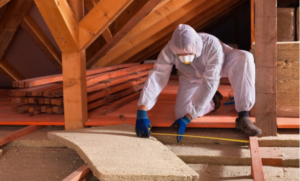Plumbing systems remove waste water, provide hot and cold water, and regulate indoor climate through a series of pipes, fixtures and fittings. These systems are vital to our everyday lives and require regular maintenance to prevent clogs, leaks and other problems.
Plumbers work in residential and commercial settings. They install and repair piping, appliances and fixtures, such as sinks, toilets and water heaters. Click the https://www.proplumbersauroraco.com/ to learn more.

While many jobs require a lot of time at the desk hunched over a computer, plumbers get out into the field and interact with new people all the time. It’s the perfect job for someone who thrives on social interaction and a desire to make a difference in people’s lives.
Plumbers are responsible for installing, repairing and maintaining pipes and fixtures in residential and commercial buildings. They also work on sewers and water systems, identifying problems and resolving them according to plumbing codes. They must be able to read blueprints and technical drawings, and they need strong knowledge of materials and tools.
They install, repair and replace pipes and fittings such as faucets, valves, drains, toilets, sinks, urinals, bathtubs, showers and more. They may also install and repair backflow preventer devices and inspect, test and analyze systems to diagnose piping problems. Plumbers also repair or replace water heaters and other equipment such as tankless water heaters, garbage disposals, steam irons, gas furnaces and hot water heaters.
In addition, they may need to perform light construction, carpentry, painting, plastering and flooring work. They must be able to follow and understand plumbing and building codes, and they should have the ability to collaborate with general contractors, electricians and other professionals on site. They need to be able to work under tight deadlines and with limited supervision, and they must have the ability to communicate effectively.
Plumbers also need to be able to observe and detect plumbing system failures or defects by examining components, equipment and parts, inspecting and testing devices, and making observations. They also need to be able to dismantle devices, reassemble and repair them. They must also be able to interpret building plans, blueprints and plumbing schematics.
Plumbers contribute significantly to society by maintaining the supply of fresh water and removing wastewater safely and efficiently. They help save lives by preventing the spread of deadly diseases. In addition, they keep buildings clean by ensuring that their plumbing works well. They also reduce environmental pollution by encouraging the use of low-flush toilets and water flow restrictors.
Education and Training Requirements
In order to pursue a career as a plumber, it is necessary to have both on-the-job experience and formal training. In addition to courses in safety and code compliance, many trade schools and associations offer training on specific plumbing systems and products. This is especially important for plumbers who wish to specialize in areas like gas plumbing, steam fitting or green plumbing.
To become a licensed plumber, it is typically necessary to complete an apprenticeship program and gain several years of experience on-the-job. Most programs are administered by local unions or UA local chapters, and they usually combine classroom instruction with on-the-job training. Many of these programs are state- or federally-approved, which ensures that they adhere to strict standards and provide high quality education.
Apprenticeships can be found through local unions and UA local chapters as well as through community colleges, career and technical education (CTE) programs and BOCES (Board of Cooperative Educational Services). Some programs are offered to high school students, giving them an opportunity to earn while they learn. Others are open to adults, and they may require an interview or entrance exam.
During this time, plumbers will be exposed to many different types of projects and environments. This allows them to gain a wide range of skills and experiences that they can use in their future careers. It is also an important time to develop professional relationships with other plumbers, contractors and clients, as this can help them obtain future jobs.
As plumbers gain experience, they will be entrusted with more complex tasks. This can include designing plumbing systems, diagnosing plumbing issues and managing larger-scale projects. Having a strong working knowledge of blueprints and rough drawings is beneficial, as is familiarity with materials like copper, PVC, CPVC, cast iron and water-efficient fixtures. It is also helpful for plumbers to maintain proficiency with hand and power tools, and it is a good idea for them to take continuing education classes to keep their skills current.
Many trade schools and community colleges in New York offer advanced courses in plumbing, including advanced technology, green plumbing practices, and pipefitting. Some of these schools also offer specialty certifications, such as in steam fitting or plumbing systems design, which can improve job opportunities and salary potential.
Work Environment
Plumbing systems are vital to the safety and comfort of people living in residential, commercial, and industrial spaces. Plumbers use their technical knowledge and experience to maintain, repair, and install these systems. They also ensure that they adhere to local and national building codes and regulations when working on plumbing installations. Whether they work on small or large projects, plumbers typically have a busy and varied work environment.
The job site may be indoors or outdoors, depending on the type of project. Plumbers who are part of a construction team typically work on new construction sites, where they lay out piping and fixtures according to blueprints and specifications. These plumbers often collaborate with other construction tradespeople and engineers to ensure that the plumbing is integrated properly into the overall building plans.
Other plumbers work primarily in residential spaces, installing and repairing plumbing fixtures like sinks, toilets, bathtubs, showers, and water heaters. They may also be responsible for maintaining septic systems and dealing with issues related to water supply and drainage lines in these buildings. In some cases, these plumbers may also be required to provide emergency services for residents, such as responding to calls about burst pipes or clogged drains.
Plumbing schools and apprenticeship programs both provide aspiring plumbers with the skills and experience they need to succeed in the field. They will learn about all aspects of the plumbing profession, from how to read blueprints and understand building codes to how to install various types of fixtures and appliances. Apprenticeships typically last from four to five years, and they combine classroom instruction with on-the-job training. Many states require that aspiring plumbers complete an apprenticeship before they can take the state licensing exam.
Other important skills that plumbers need to have include excellent customer service, critical thinking, and dexterity. They need to be able to weigh different solutions to problems and determine which is the best option given the circumstances. They also need to be comfortable working in confined spaces and using hand tools and power tools, such as wrenches, pipe cutters, and soldering equipment.
Salary
As with most jobs, the salary of plumbers depends on several factors. These include location, certifications, and years of experience. In general, plumbers with more experience tend to earn higher salaries. This is because master plumbers have been in the trade for a long time, and they know how to handle all kinds of problems.
However, the most important factor that influences plumbing salaries is location. For instance, a plumber’s income is usually much higher in large cities with high living costs than in smaller towns where the cost of living is lower. It is also important to note that the average salary for plumbers varies by state.
For example, the average plumber salary in the state of Illinois is $77,570 per year. This is significantly higher than the average plumber salary in other states, including New York and Hawaii.
Additionally, the salaries for plumbers also vary by industry. For instance, plumbers who work in commercial and industrial buildings make more money than those who work in residential homes. This is because commercial and industrial plumbers have to deal with more complicated plumbing issues, such as dealing with a larger volume of water than residential plumbers do.
Another thing that can influence plumber salaries is the type of work that the plumber does. For instance, plumbers who specialize in kitchen and bathroom remodeling may earn more than those who work on simple plumbing repairs. This is because the responsibilities of plumbers who specialize in kitchen and bathroom remodeling are much more complex than those of a standard plumber.
In addition, the amount that plumbers make can depend on whether they are in union or non-union organizations. For instance, plumbers in union organizations often earn more than those in non-union organizations, as they are able to negotiate higher wages and benefits.
Another way that plumbers can increase their salaries is by starting their own company. While this is a huge step and requires a lot of hard work, it can be one of the best ways to boost your career. Managing your own business can help you improve client relationships, streamline operations, and make more money. In addition, you can use tools and templates to help you run your business more efficiently and effectively.








